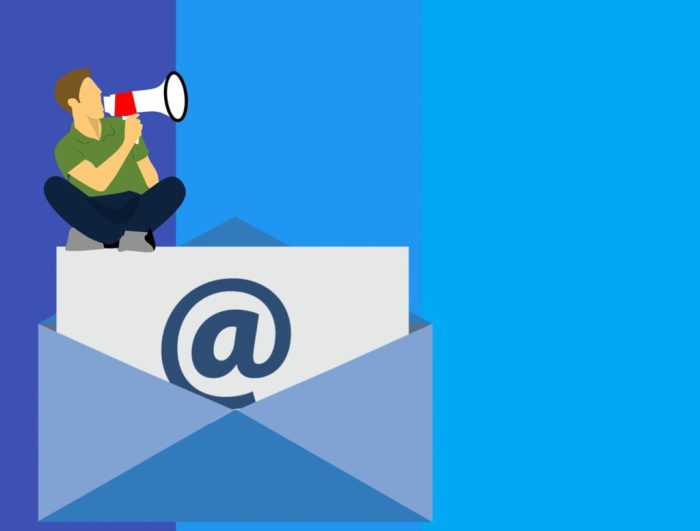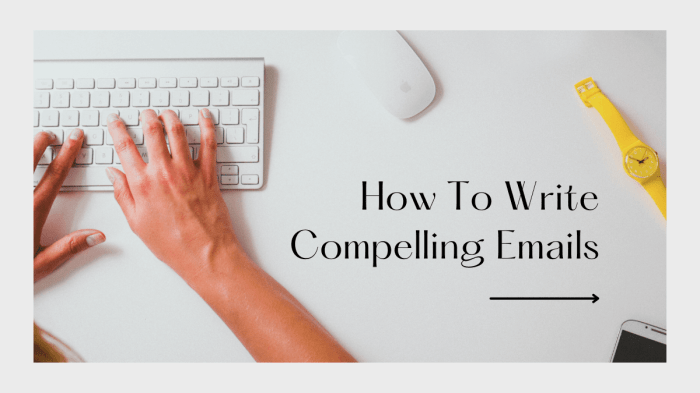Writing Compelling Emails sets the stage for impactful communication, combining creativity and strategy to craft messages that captivate and drive action. Dive into the world of email mastery with tips and tricks that will elevate your outreach game.
Discover the secrets behind creating emails that resonate with your audience and compel them to take the desired action, all while maintaining a professional and engaging tone that keeps them coming back for more.
Importance of Writing Compelling Emails
When it comes to professional communication, writing compelling emails is absolutely essential. It’s not just about getting your message across; it’s about capturing the attention of your audience and driving them to take action.
Compelling emails have the power to increase engagement and response rates significantly. By crafting emails that are interesting, persuasive, and visually appealing, you can grab the recipient’s attention and keep them interested in what you have to say.
Examples of Successful Email Campaigns
- Apple’s product launch emails: Apple is known for its sleek design and innovative products. Their email campaigns are no exception, with visually stunning layouts and compelling copy that entices customers to learn more about their latest offerings.
- Amazon’s personalized recommendations: Amazon has mastered the art of personalized recommendations in their email campaigns. By using customer data to suggest products that are tailored to each individual’s preferences, they have seen a significant increase in click-through rates and sales.
- Dollar Shave Club’s humorous approach: Dollar Shave Club is famous for its quirky and humorous marketing campaigns, and their emails are no different. By injecting humor and personality into their emails, they have built a strong connection with their audience and seen a boost in customer loyalty.
Elements of a Compelling Email: Writing Compelling Emails

Crafting a compelling email involves incorporating key elements that grab the reader’s attention and resonate with them on a personal level. From the subject line to the content within the email, every aspect plays a crucial role in engaging the recipient.
Strong Subject Line
A strong subject line is essential in capturing the reader’s interest and enticing them to open the email. It should be concise, impactful, and relevant to the content of the email. Using actionable language, posing a question, or creating a sense of urgency can all help in making the subject line compelling.
Personalization and Relevance
Personalization and relevance are key components of a compelling email. Tailoring the content to the recipient’s interests, preferences, or previous interactions can make the email feel more personalized and engaging. Additionally, ensuring that the content is relevant to the recipient’s needs or challenges can increase the chances of them engaging with the email.
Writing Style and Tone
When it comes to writing compelling emails, the tone you use can make a big difference in how your message is received. A well-crafted tone can help engage the reader and convey your message effectively. Here are some tips on writing style and tone to keep in mind:
Maintaining a Professional Yet Engaging Writing Style, Writing Compelling Emails
To maintain a professional yet engaging writing style in your emails, consider the following tips:
- Avoid using overly formal language that may come across as stiff or impersonal.
- Use a friendly and conversational tone to connect with your audience on a more personal level.
- Keep the content clear, concise, and to the point to maintain the reader’s interest.
- Incorporate storytelling techniques to make your message more engaging and memorable.
- Use active voice and strong verbs to convey a sense of urgency and importance.
Language that Resonates with the Target Audience
When writing emails, it’s essential to use language that resonates with your target audience. Here are some key points to consider:
- Understand your audience’s preferences and communication style to tailor your language accordingly.
- Use industry-specific jargon or terminology that your audience is familiar with to establish credibility.
- Personalize your message by addressing the reader by name and referencing previous interactions or shared experiences.
- Consider the emotional tone of your language to evoke the desired response from your audience.
- Use inclusive language to make all recipients feel involved and valued in the communication.
Call to Action (CTA) Strategies
When it comes to crafting compelling CTAs, it’s essential to be clear, concise, and persuasive. Your CTA should prompt the recipient to take a specific action, whether it’s making a purchase, signing up for a newsletter, or attending an event. Here are some best practices to keep in mind:
Crafting Clear and Persuasive CTAs
- Use action-oriented language: Start your CTA with a strong verb to encourage immediate action, such as “Shop Now,” “Sign Up Today,” or “Learn More.”
- Keep it concise: Make sure your CTA is short and to the point, so it’s easy for the recipient to understand and act upon quickly.
- Highlight the benefits: Clearly communicate the value or benefit the recipient will get by clicking on the CTA, whether it’s a discount, exclusive offer, or valuable information.
Examples of Effective CTAs
- “Get Your Free Trial Now”
-This CTA offers a clear benefit and creates a sense of urgency to act now. - “Limited Time Offer: Buy One, Get One Free”
-By highlighting the time-sensitive nature of the offer, this CTA creates a sense of urgency without being pushy. - “Join Our Exclusive VIP Club Today”
-This CTA appeals to the recipient’s desire for exclusivity and special perks.
Creating a Sense of Urgency in the CTA
- Use phrases like “Limited Time Offer,” “Act Now,” or “Don’t Miss Out” to create a sense of urgency without coming across as overly aggressive.
- Include a deadline or expiration date to motivate the recipient to take action quickly.
- Emphasize scarcity: Highlight that the offer is available only to a limited number of people or for a limited time to create a fear of missing out.
Formatting and Design

When it comes to writing compelling emails, the way your message is formatted and designed plays a crucial role in capturing the reader’s attention and conveying your message effectively. Proper formatting enhances readability and ensures that your email is visually appealing, increasing the chances of engagement.
Importance of Email Formatting for Readability
Effective email formatting is essential for readability as it helps break down the content into digestible chunks. Use short paragraphs, bullet points, and subheadings to organize your thoughts and make it easier for the reader to scan through the email quickly. Avoid long blocks of text that can overwhelm the reader and lead to disinterest.
Tips for Using Visuals and White Space Effectively in Emails
Incorporating visuals such as images, infographics, and videos can grab the reader’s attention and make your email more engaging. However, make sure the visuals are relevant to the content and do not overcrowd the email. Utilize white space strategically to create a clean and uncluttered layout that guides the reader’s eyes to the most important information.
Role of Mobile Responsiveness in Email Design
With the increasing use of smartphones and tablets, it’s crucial to ensure that your emails are mobile-responsive. This means that your email can adapt to different screen sizes and devices, providing a seamless viewing experience for recipients on the go. A mobile-responsive design improves readability and usability, ultimately enhancing the effectiveness of your email campaigns.
